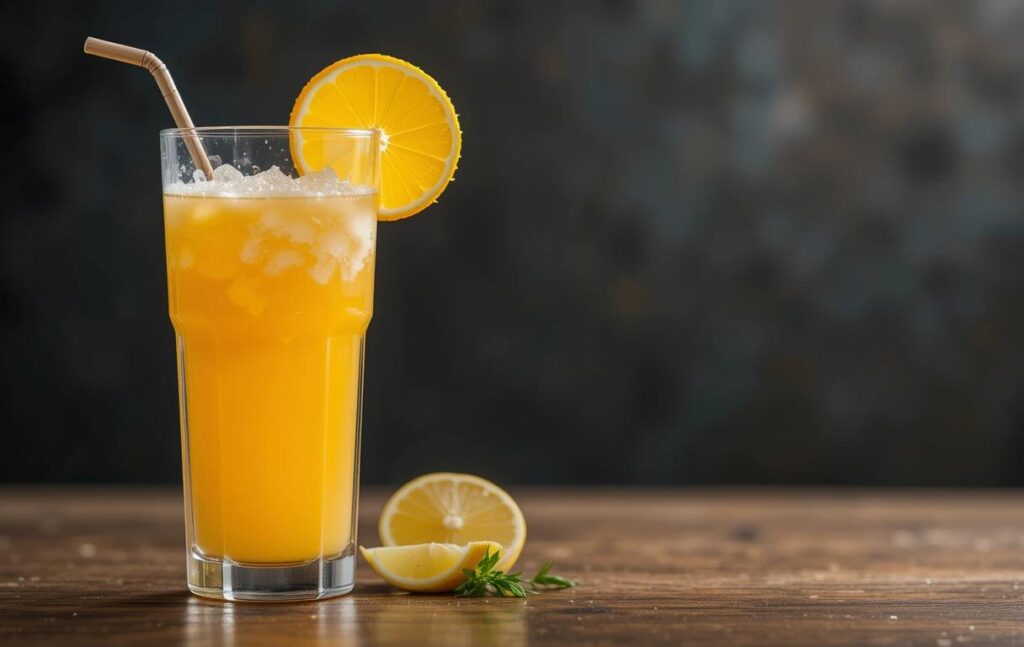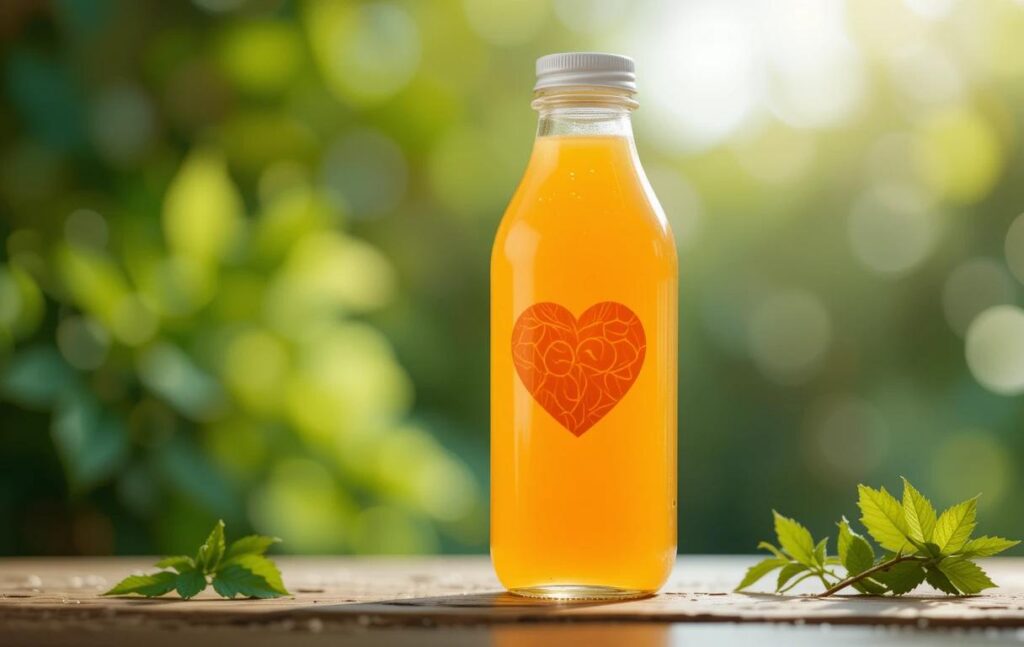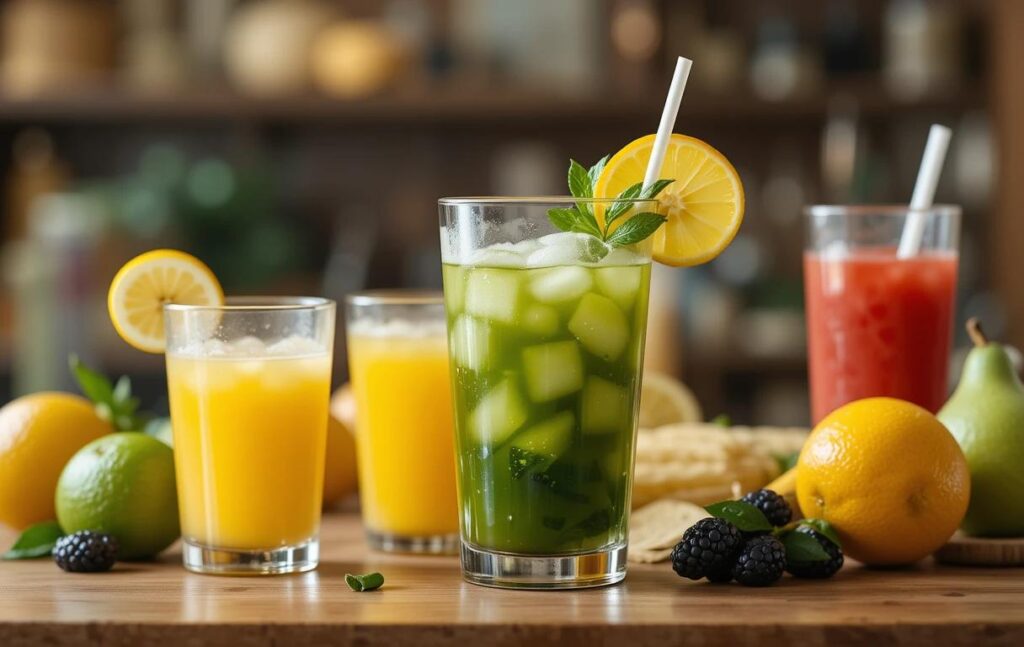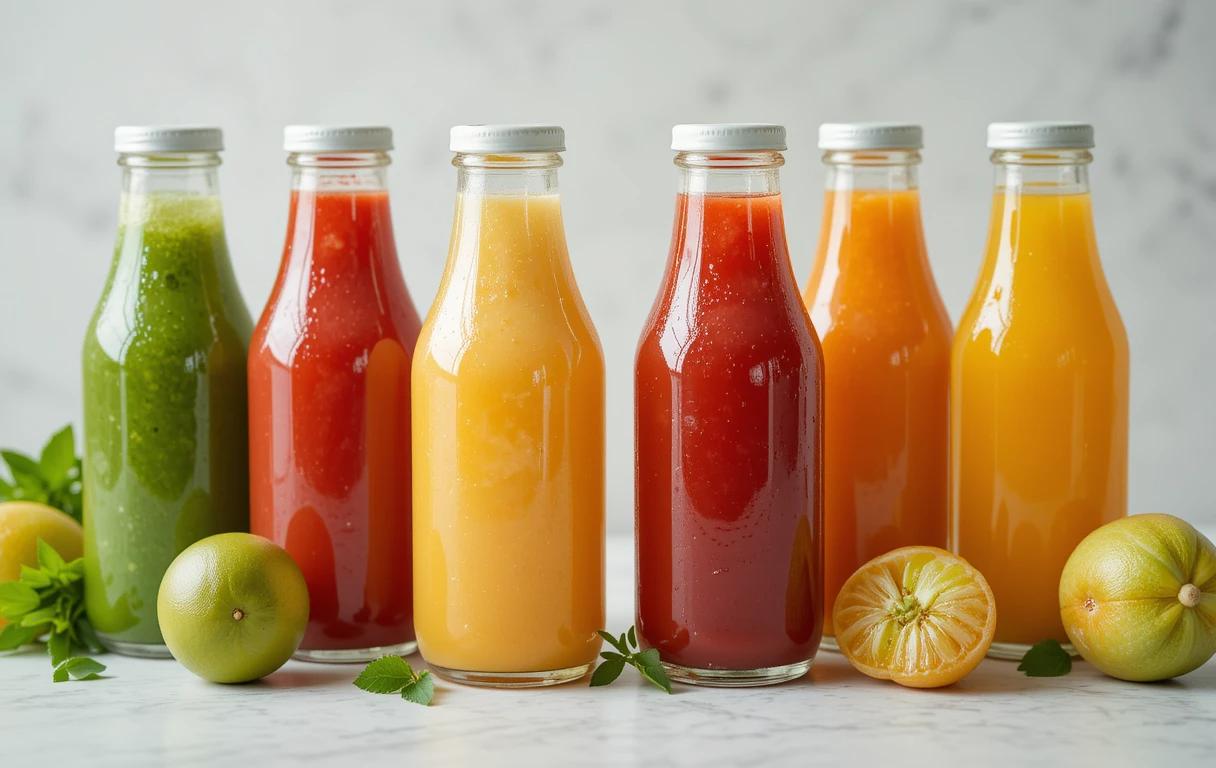Does a Juice Cleanse Help Lose Belly Fat?
Juice cleanses have gained immense popularity in the wellness community as a quick way to detox, shed pounds, and reboot your health. Among these claims, many wonder, “Can a juice cleanse help lose belly fat?” This article dives into the science and facts to uncover whether juice cleanses are truly effective for targeting belly fat or if they’re simply another health trend.
We’ll explore what juice cleanses are, how they work, and their potential benefits and risks. We’ll also answer frequently asked questions and provide practical tips for safe cleansing. Let’s get started!
What is a Juice Cleanse?
A juice cleanse is a type of diet where individuals consume only fruit and vegetable juices for a specified period, typically ranging from one to seven days. The primary goal of a juice cleanse is to detoxify the body, provide a nutrient boost, and support weight loss. Juice cleanses often promise benefits like increased energy, clearer skin, and even fat reduction, particularly around the belly.
While most cleanses involve replacing all meals with juices, some allow for light snacks or specific foods like nuts or salads. These juices are usually fresh, cold-pressed, and rich in vitamins and minerals, offering a concentrated source of nutrition without solid food.
How Juice Cleanses Work ( to cleanse help lose belly fat)
Juice cleanses work by reducing calorie intake and flooding the body with micronutrients while giving the digestive system a break from heavy meals. The theory is that this allows the body to focus on eliminating toxins, enhancing metabolism, and promoting fat loss. Since the juices are low in fiber and high in natural sugars, they may also stabilize blood sugar levels temporarily, reducing bloating and inflammation.
However, it’s important to note that the body naturally detoxifies through the liver and kidneys, regardless of diet. While juices can provide a concentrated dose of nutrients, their role in “detoxification” is more supplemental than transformative.
Popular Types of Juice Cleanses
Juice cleanses come in various formats to suit different preferences and goals. The most common types include:
- One-Day Cleanse: A short detox to give the digestive system a break while providing a nutrient boost.
- Three-Day Cleanse: The most popular choice, aimed at resetting the body and kickstarting weight loss.
- Seven-Day Cleanse: A more intensive option often promoted as a full-body detox for more significant results.
- Custom Cleanses: Some people opt for cleanses tailored to their unique needs, combining specific ingredients or durations.
Each type of cleanse varies in intensity and results, with shorter cleanses being less disruptive to daily life but offering fewer noticeable benefits.
Can a Juice Cleanse Target Belly Fat?

One of the most common questions about juice cleanses is whether they can specifically target belly fat. The short answer is no—it’s impossible to spot-reduce fat through any diet or exercise. However, juice cleanses may lead to temporary weight loss, which might include a reduction in belly circumference due to water weight and bloating.
Understanding Belly Fat
To understand if a juice cleanse can help lose belly fat, it’s essential to know the types of fat stored in the abdominal region:
- Subcutaneous Fat: This is the fat stored directly under the skin and makes up a significant portion of body fat. It’s less harmful but contributes to the appearance of a “soft” belly.
- Visceral Fat: This type of fat wraps around vital organs like the liver and intestines. It’s linked to serious health issues such as heart disease, diabetes, and inflammation.
Losing visceral fat is crucial for improving overall health, but it requires consistent lifestyle changes, including diet and exercise. Juice cleanses may contribute to temporary subcutaneous fat reduction through calorie deficits, but their impact on visceral fat is limited.
Scientific Evidence Behind Juice Cleanses
Scientific studies on juice cleanses provide mixed results, often highlighting temporary benefits rather than long-term changes. Here’s a breakdown of the findings:
- Caloric Deficit: Juice cleanses can create a significant caloric deficit, leading to short-term weight loss. However, much of this loss is water weight, not fat.
- Reduced Bloating: The low-fiber nature of juices can ease digestion and reduce bloating, leading to a flatter appearance in the belly area.
- Lack of Fat-Specific Evidence: There is no direct evidence suggesting juice cleanses target belly fat specifically. Weight loss is typically generalized across the body.
- Impact on Insulin Sensitivity: Some studies suggest that intermittent fasting or low-calorie diets, like juice cleanses, may temporarily improve insulin sensitivity, reducing abdominal fat storage. However, these effects are often short-lived.
Can Juice Cleanses Truly Burn Fat?
Burning fat requires more than just consuming juices—it’s a metabolic process that involves creating a calorie deficit while maintaining muscle mass through activity. Juice cleanses alone rarely provide the protein necessary to preserve muscle or sustain metabolism. While they may jumpstart weight loss, this is primarily due to:
- Loss of Glycogen Stores: The body burns through glycogen during a cleanse, releasing water weight.
- Lower Calorie Intake: With fewer calories consumed, the body may begin to utilize fat stores, albeit minimally.
Ultimately, a juice cleanse can support overall fat loss when paired with a healthy lifestyle, but it’s not a magic solution for belly fat.
Benefits of Juice Cleanses ( to cleanse help lose belly fat)
While juice cleanses may not directly target belly fat, they do offer several potential benefits that can contribute to overall health and wellness:
Detoxification and Improved Digestion
Juice cleanses are often marketed as a way to “detox” the body. While your liver and kidneys naturally handle detoxification, the light, easily digestible nature of juices can reduce digestive workload. This can help alleviate bloating and improve gut health temporarily, creating a sensation of lightness in the abdominal area.
- Key Ingredients for Detox: Juices often include ingredients like ginger, lemon, and celery, which are known for their anti-inflammatory properties.
- Hydration Factor: Juices are mostly water, which helps flush toxins and keep the body hydrated, supporting digestion and overall health.
Nutrient Boost
Juices are packed with vitamins, minerals, and antioxidants that support various bodily functions. For instance:
- Vitamin C from citrus fruits: Boosts immunity and promotes skin health.
- Potassium from leafy greens: Balances sodium levels, which can help reduce water retention.
- Antioxidants from berries: Fight inflammation and may contribute to fat oxidation.
Regular consumption of such nutrient-rich juices can supplement deficiencies and give your body the tools it needs for optimal functioning.
Kickstart for Healthy Habits
A juice cleanse can act as a psychological reset, encouraging healthier eating habits. After completing a cleanse, many individuals find it easier to transition to a balanced diet, reducing processed foods and sugar, which can indirectly aid in reducing belly fat.
Risks and Downsides of Juice Cleanses

Despite the benefits, juice cleanses have significant downsides that should be considered before diving in:
Lack of Sustainable Fat Loss
While juice cleanses can lead to rapid weight loss, most of this is due to water loss and reduced glycogen stores. Once you resume a regular diet, this weight often returns. Long-term fat loss requires consistent calorie deficits, balanced macronutrients, and physical activity.
Potential Nutrient Deficiencies
Juice-only diets lack essential nutrients like protein, fiber, and healthy fats. This can lead to:
- Muscle Loss: Without protein, the body may break down muscle tissue for energy, slowing metabolism.
- Fiber Deficiency: Fiber is crucial for gut health and sustained satiety, and juices remove most of the fiber from fruits and vegetables.
- Energy Slumps: Low-calorie intake can cause fatigue, irritability, and difficulty concentrating.
Risk of Blood Sugar Spikes
The high natural sugar content in juices, combined with a lack of fiber, can lead to blood sugar fluctuations. This is particularly concerning for individuals with insulin resistance or diabetes.
Finding Balance
Juice cleanses can be beneficial in moderation and when used as a short-term reset rather than a long-term solution. Pairing juices with whole foods and a healthy lifestyle ensures the benefits outweigh the risks.
Tips for Safe and Effective Juice Cleanses
Embarking on a juice cleanse requires careful planning to ensure safety and maximize benefits. Here are practical tips to make your cleanse as effective and sustainable as possible.
Incorporate Solid Foods
While traditional juice cleanses rely solely on liquid nutrition, incorporating small, nutrient-dense meals can enhance your experience. Pairing juices with light meals such as salads, steamed vegetables, or protein-rich snacks can help maintain energy levels and prevent muscle loss.
- Examples of Healthy Additions:
- Avocado toast on whole-grain bread
- A handful of almonds or walnuts
- Quinoa salad with mixed greens and olive oil
This approach balances the caloric deficit while avoiding extreme hunger or nutrient deficiencies.
Choose the Right Juices
Not all juices are created equal. For the best results, prioritize fresh, cold-pressed juices made from a mix of fruits and vegetables. Avoid juices that are overly sweet or processed, as these can negate the cleanse’s benefits.
- Key Ingredients to Include:
- Greens: Spinach, kale, cucumber, and celery for minerals and hydration.
- Citrus: Lemon, lime, and orange for vitamin C and antioxidants.
- Roots: Ginger and turmeric for anti-inflammatory benefits.
Opt for a balance of vegetables over fruits to minimize sugar content.
Stay Hydrated
Juices alone may not provide enough hydration throughout the day. Drinking plenty of water alongside your cleanse is essential to flush out toxins and support bodily functions. Herbal teas and electrolyte-rich drinks can also help maintain hydration levels.
Limit the Duration
Juice cleanses are most effective when kept short—typically one to three days. Extended cleanses can lead to nutrient deficiencies and slow metabolism. If you’re looking for long-term health improvements, consider integrating juices into your regular diet rather than relying on a prolonged cleanse.
Maintain Light Exercise
Although strenuous workouts should be avoided during a juice cleanse, light physical activities such as yoga, walking, or stretching can enhance the detox process. These activities promote blood flow, reduce stress, and support overall well-being.
Monitor Your Body’s Signals
Listen to your body throughout the cleanse. If you feel excessively weak, dizzy, or irritable, consider incorporating more solid foods or ending the cleanse early. Your health should always take priority over the regimen.
Transition Back Gradually
After completing a juice cleanse, reintroduce solid foods gradually to prevent digestive discomfort. Start with soft, easily digestible options like smoothies, soups, and steamed vegetables before moving on to heavier meals.
Benefits of a Balanced Approach

A juice cleanse can be a great way to reset your habits and jumpstart your health, but balance is key. Incorporating these tips ensures that your cleanse is safe, effective, and supportive of your overall wellness goals.
FAQs ( to cleanse help lose belly fat)
Here are answers to some of the most commonly asked questions about juice cleanses and their effectiveness for losing belly fat:
Q1: Can I lose belly fat with a juice cleanse?
A: While juice cleanses can lead to temporary weight loss, they do not specifically target belly fat. Much of the initial weight loss comes from water and glycogen depletion, not fat.
Q2: How long should a juice cleanse last?
A: Most experts recommend short cleanses of one to three days. Prolonged cleanses may result in nutrient deficiencies and metabolic slowdown.
Q3: What’s the best juice for reducing belly fat?
A: Juices with a high vegetable-to-fruit ratio, including ingredients like celery, spinach, cucumber, and lemon, are excellent for reducing bloating and promoting a flat stomach.
Q4: Are juice cleanses safe for everyone?
A: Juice cleanses may not be suitable for individuals with certain health conditions, such as diabetes or kidney issues. Always consult a healthcare professional before starting.
Q5: Will I gain the weight back after a juice cleanse?
A: Weight regain is common after a cleanse, especially if you return to a high-calorie diet. To maintain results, adopt a balanced diet and active lifestyle post-cleanse.
Q6: Can I exercise during a juice cleanse?
A: Yes, but stick to light exercises like yoga or walking. High-intensity workouts may be challenging due to reduced calorie intake.
Conclusion
Juice cleanses can serve as a helpful reset for your body and mind, offering benefits like improved digestion, reduced bloating, and a nutrient boost. However, they are not a guaranteed solution for losing belly fat or achieving sustainable weight loss. The initial results are often temporary and primarily due to water loss rather than fat reduction.
To effectively lose belly fat, focus on long-term strategies like a balanced diet, regular exercise, and consistent hydration. Juice cleanses can complement these efforts but should not replace a comprehensive approach to health and wellness.
By understanding the limitations and adopting a balanced approach, you can enjoy the benefits of juice cleanses while setting realistic goals for your body and lifestyle.
Homemade Tomato Juice Cocktail
Related Recipes
- “Tuna Tomato Sauce Pasta Recipe“: A tomato-based recipe showcasing another way to use tomatoes.
- “Baked Chicken Fettuccine Alfredo with Broccoli“: Another comforting dish that can be complemented with tomato-based sauces.
Ingredient-Focused Content
- “Lions Mane Mushroom Recipe“: Suggest using a tomato gravy as a flavorful addition for plant-based dishes.
Cooking Techniques and Enhancements
- “Mango Habanero Salsa“: Explore complementary uses of sauces and gravies for flavor diversity.
Storage and Reuse Tips
- “Sous Vide Recipes“: Recommend tomato gravy as a sauce for sous vide-cooked meats or vegetables.
- “Ocean Spray Cranberry Sauce Recipe“: Guide readers on making and storing sauces, including tomato gravy.

